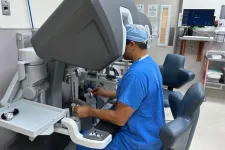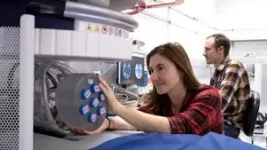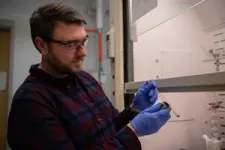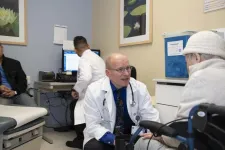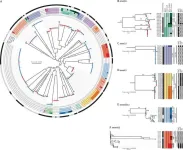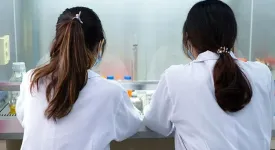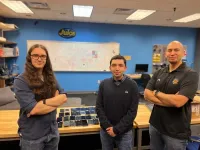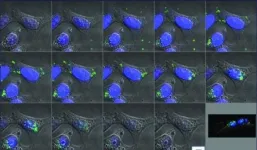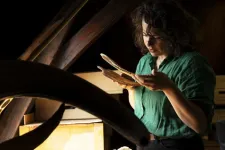(Press-News.org) A surgical team from Washington University School of Medicine in St. Louis recently performed the first robotic liver transplant in the U.S. The successful transplant, accomplished in May at Barnes-Jewish Hospital, extends to liver transplants the advantages of minimally invasive robotic surgery: a smaller incision resulting in less pain and faster recoveries, plus the precision needed to perform one of the most challenging abdominal procedures.
The patient, a man in his 60s who needed a transplant because of liver cancer and cirrhosis caused by hepatitis C virus, is doing well and has resumed normal, daily activities. Typically, liver transplant recipients require at least six weeks before they can walk without any discomfort. The patient was not only walking easily one month after surgery but also cleared to resume golfing and swimming.
“The transplant was a success: The operation went smoothly, the new liver started working right away, and the patient recovered without any surgical complications,” said transplant surgeon Adeel Khan, MD, the leader of the team that conducted the trailblazing surgery. Khan is an associate professor of surgery at the School of Medicine. “Liver transplantation is one of the most complex abdominal operations and heavily relies on a specialized team for good outcomes. Here at Washington University and Barnes-Jewish Hospital, we are very fortunate to have the support needed to develop a world-class robotic-transplant team that allows us to safely perform complex operations. This team is a big part of our success.”
A liver transplant traditionally is performed as an “open” procedure, with a surgeon making a 3- to 4-inch vertical and 12- to 16-inch horizontal incision just below the rib cage to remove a patient’s diseased liver and place the healthy donated liver. There has been a push by transplant surgeons to shift the procedure to one that is minimally invasive – with smaller incisions that typically result in less pain and faster recoveries. Yet, most transplant surgeries have been thought to be too complicated for a minimally invasive approach – whether performed laparoscopically or robotically — and liver transplants are particularly challenging. Diseased livers are prone to excessive bleeding during surgery to remove them, and attaching the new liver to the patient’s circulatory system requires delicately sewing several tiny blood vessels together.
Robotic surgeries are a kind of minimally invasive surgery. Surgeons maintain complete control of the robot’s tools and perform the operations remotely — usually just a few feet away from the patient — using joystick-like controls. High-resolution cameras provide a magnified, 3D view of the surgical site viewable via a large monitor. The high-tech instrumentation allows for very precise, fine manipulations that would be impossible using traditional techniques.
For this robotic liver transplant, the surgeons operated through several half-inch keyhole incisions and made a single 6-inch vertical incision between the abdominal muscles for removing the diseased organ and placing the new liver, which is about the size of a football, inside the abdomen. This incision is considerably smaller than the one used traditionally and does not require cutting through abdominal muscles, enabling a faster recovery.
While the patient’s physical recovery has been on schedule, he did require extra time in the hospital due to cognitive symptoms that are not unusual in older patients after major surgery.
The robotic liver transplant took just over eight hours — on the high end but within the expected time frame for traditional open liver transplants, which usually take six to eight hours. Future robotic liver transplants likely will be completed faster as the OR team gains experience and gets more used to the subtleties of the new surgical technique, Khan said.
A South Korean team reported the first robotic liver transplant in the world in 2021. That surgery involved transplanting half a liver from a living donor instead of the whole organ, and the surgery was partially robotic; the diseased liver was removed laparoscopically and the new liver implanted robotically. Khan said his team is the first to perform a robotic liver transplant in which a whole liver was transplanted.
“Liver transplantation is the most difficult of the abdominal organs to consider for a minimally invasive approach — given the difficulty of removing a failing liver and successfully implanting the new organ — but Dr. Khan has shown that this is possible,” said William Chapman, MD, the Eugene M. Bricker Professor of Surgery, director of Washington University’s Division of General Surgery and chief of the transplant surgery section. “Further experience with this technique will be needed to establish the extent of the benefits of performing liver transplant as a minimally invasive approach.”
Washington University and Barnes-Jewish Hospital have focused heavily on robotic surgery as part of a concerted effort to advance minimally invasive surgeries and improve patient outcomes. The robotic transplant team was formed five years ago, with an initial focus on kidney transplants. To date, the team has performed more than 30 robotic kidney transplants, all with good outcomes. The team also performs living-donor kidney removal surgery, and other robotic surgeries involving the liver, bile ducts, pancreas and stomach.
“Over the span of several years, we have built a dedicated robotic transplant team that is second to none and has been instrumental to our success,” Khan said. “Once we had this team in place, it allowed us to grow in both number and complexity of the cases while maintaining very good patient outcomes. We have five surgeons on the transplant service doing robotic surgery, and this number will increase to seven by the end of the summer. Since starting our program, we have mentored over 30 transplant centers around the country in building successful robotic programs of their own. Transplant teams from other centers come to observe our process, and we also visit their sites and mentor them as they develop their skills. We are probably one of the very few places in the country that has the support, expertise and team to take robotic transplant surgery to this level.”
END
First robotic liver transplant in U.S. performed by Washington University surgeons
Groundbreaking surgery performed at Barnes-Jewish Hospital in St. Louis
2023-07-17
ELSE PRESS RELEASES FROM THIS DATE:
Rice study: Men vastly outnumber women in studying legislative politics
2023-07-17
It’s no secret that men outnumber women in the halls of Congress and in other political arenas, but new research from Rice University, the University of Wisconsin-Madison and the University of Illinois Urbana-Champaign also found that significantly more men than women study the legislative process in the U.S. and abroad.
This has troubling implications for the inner workings of the discipline and the overall study of topics that impact women’s political involvement, according to Leslie Schwindt-Bayer, the Thomas Cooke and Mary Elizabeth Edwards Chair in Government and Democracy ...
City of Hope-led panel of experts updates cancer and aging guidelines issued by the American Society of Clinical Oncology
2023-07-17
LOS ANGELES — In an effort to improve treatment outcomes and quality of life for older adults with cancer, researchers from City of Hope, one of the largest cancer research and treatment organizations in the United States, and colleagues across the country today released updated guidelines by the American Society of Clinical Oncology (ASCO) outlining the need to assess and manage vulnerabilities in patients aged 65 and older prior to prescribing chemotherapy, targeted therapy and/or immunotherapy.
The updated recommendations, published in the Journal of Clinical Oncology, urges the clinical use of a validated geriatric assessment (GA) — defined as an evaluation ...
Survival of children with acute lymphatic leukemia further increased
2023-07-17
The five-year survival of all children with acute lymphatic leukemia (ALL) has continued to increase to 94%. This is evident from a study of 800 Dutch children. Within the study, modified treatment protocols for four subgroups were examined. The modifications were found to have positive effects on survival and quality of life. For example, the risk of disease recurrence became as much as three times smaller for children with an aggressive form of leukemia. Says Prof. Dr. Rob Pieters: ‘The five-year ...
Bacteria discreetly dwelling in throat revealed to be primary source of Strep A transmission
2023-07-17
Breakthrough research has found that Group A Streptococcus (GAS) infections are more likely transmitted from asymptomatic throat carriage than skin-to-skin contact in communities with high rates of infection.
This major discovery has far-reaching implications for public health approaches, vaccine development and future research as it challenges previous understanding of how the bacterium is spread.
GAS (Streptococcus pyogenes), commonly found on the skin and in the throat, can cause infections ranging from sore throats and impetigo (skin infections) to deadly bloodstream infections. In places like remote First Nations communities where the pathogen is ...
First study to directly compare gene mutation type in individuals with CHAMP1 disorder indicates key differences
2023-07-17
New research led by the Seaver Autism Center for Research and Treatment at Mount Sinai has illuminated genetic differences among children with a rare neurodevelopmental condition and could point the way toward a precision medicine approach to caring for these children.
The study is the first of its kind to directly assess differences between individuals with mutations in the CHAMP1 gene and those with deletions of the gene. The analysis was published in Human Genetics on July 17.
CHAMP1 disorder is a genetic, neurodevelopmental condition associated with intellectual disability, medical comorbidities (e.g., seizures, gastrointestinal problems), and dysmorphic ...
Innovative infection prevention program reduces surgical site infections, results in hospital days reduced and $500,000 savings
2023-07-17
Chicago — An innovative anesthesiologist-led infection prevention program helped reduce the number of surgical site infections (SSIs) in colorectal patients by 50%, the number of days in the hospital by 46%, and led to significant cost savings over a two-year period, according to research presented at the virtual American Society of Anesthesiologists’ Anesthesia Quality and Patient Safety Meeting.
“With the skyrocketing cost of medical care for patients and health care institutions, one area physicians can focus on is reducing SSIs,” ...
Shrinking light: Nanoscale optical breakthrough
2023-07-17
Imagine shrinking light down to the size of a tiny water molecule, unlocking a world of quantum possibilities. This has been a long-held dream in the realms of light science and technology. Recent advancements have brought us closer to achieving this incredible feat, as researchers from Zhejiang University have made groundbreaking progress in confining light to subnanometer scales.
Traditionally, there have been two approaches to localize light beyond its typical diffraction limit: dielectric confinement and plasmonic confinement. However, challenges such as precision fabrication and optical loss have hindered the confinement of optical fields to sub-10 nanometer (nm) or even ...
UMD researchers uncover privacy risks in cellphones purchased at police auctions
2023-07-17
Law enforcement agencies nationwide regularly sell items that are seized in criminal investigations or are unclaimed from lost-and-found inventories. Many of these items—vehicles, jewelry, watches and electronic devices like cellphones—end up at online auction houses.
People looking for a bargain can bid on cellphones in bulk, snatching up dozens at rock bottom prices for parts or other uses. This ultimately provides revenue for the police agencies, making for a good deal for everyone involved. Or is it?
A recent study by University of Maryland security experts found that many of the phones sold ...
Bacterial protein found in the urogenital tract may contribute to reduced fertility, birth defects
2023-07-17
A team of researchers from the University of Maryland School of Maryland’s (UMSOM) Institute of Human Virology (IHV), a Center of Excellence of the Global Virus Network (GVN), published new findings that emphasize the crucial role of the urinary and genital tract microbiota in adverse pregnancy outcomes and genomic instability that originate in the womb during fetal development.
The study, published on July 17 in the Proceedings of the National Academy of Sciences of the United States of America (PNAS), established a new link between genomic instability and a protein from Mycoplasma fermentans, a kind of bacterium that commonly ...
Picky green sea turtle has travelled to the same place to eat for generations
2023-07-17
For approximately 3,000 years, generations of green sea turtles have returned to the same seagrass meadows to eat. This was discovered by Willemien de Kock, a historical ecologist at the University of Groningen, by combining modern data with archaeological findings. Sea turtles migrate between specific breeding places and eating places throughout their lives–this much was known. But the fact that this stretches over many generations highlights the importance of protecting seagrass meadows along the coasts of North Africa. The results were published in PNAS on July 17.
When young green ...
LAST 30 PRESS RELEASES:
UC San Diego Health Sciences Grant Writing Course helps launch successful research careers
Study: Many head and neck cancer trials end early. Why?
Tufts vice provost for research named Foreign Fellow of Indian National Science Academy
New model improves prediction of prostate cancer death risk
Two wrongs make a right: how two damaging variants can restore health
Overlooked decline in grazing livestock brings risks and opportunities
Using rare sugars to address alcoholism
Research alert: New vulnerability identified in aggressive breast cancer
Ruth Harris honored with SSA Distinguished Service Award
Treasure trove of data on aging publicly accessible
Trees4Adapt project to address risks from climate change and biodiversity loss through tree-based solutions
Nature Communications study from the Lundquist Institute identifies molecular mechanism underlying peripartum cardiomyopathy
Pennington Biomedical’s Dr. Gang Hu appointed to NIH Reproductive, Perinatal and Pediatric Health Review Group
World-first project shows great promise to treat low eye pressure
New technique puts rendered fabric in the best light
Brain cancer digital twin predicts treatment outcomes
Cat disease challenges what scientists thought about coronaviruses
Paulson Family Foundation makes an additional $19 million donation to Hebrew University to fund a new building for electrical engineering. Together with its previous gift brings the total donation to
Canada–Estonia partnership advances community-centered clean energy
Sandia’s economic impact sets record for 17th consecutive year
Researchers uncover how tumors become resistant to promising p53-targeted therapy
Aligning games and sets in determining tennis matches
UOC research team develops method to evaluate apps for treating depression
Extreme heat waves disrupt honey bee thermoregulation and threaten colony survival
New brain study explains how binge drinking contributes to long-lasting negative feelings
The Food and Drug Administration’s regulation of mifepristone
Prescribing patterns of potentially inappropriate central nervous system-active medications in older adults
One in four older Americans with dementia prescribed risky brain-altering drugs despite safety warnings
Social media use and well-being across adolescent development
Child poverty trends by race and ethnicity in the U.S. from 2022 to 2025
[Press-News.org] First robotic liver transplant in U.S. performed by Washington University surgeonsGroundbreaking surgery performed at Barnes-Jewish Hospital in St. Louis
